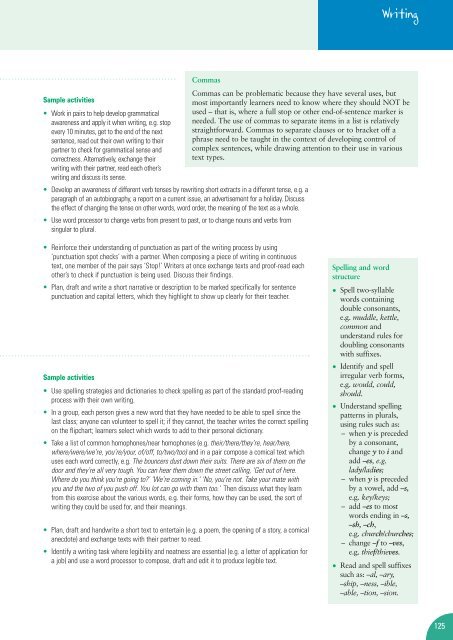Adult Literacy Core Curriculum - Nationally developed Skills for Life ...
Adult Literacy Core Curriculum - Nationally developed Skills for Life ...
Adult Literacy Core Curriculum - Nationally developed Skills for Life ...
You also want an ePaper? Increase the reach of your titles
YUMPU automatically turns print PDFs into web optimized ePapers that Google loves.
Sample activities<br />
• Work in pairs to help develop grammatical<br />
awareness and apply it when writing, e.g. stop<br />
every 10 minutes, get to the end of the next<br />
sentence, read out their own writing to their<br />
partner to check <strong>for</strong> grammatical sense and<br />
correctness. Alternatively, exchange their<br />
writing with their partner, read each other’s<br />
writing and discuss its sense.<br />
• Develop an awareness of different verb tenses by rewriting short extracts in a different tense, e.g. a<br />
paragraph of an autobiography, a report on a current issue, an advertisement <strong>for</strong> a holiday. Discuss<br />
the effect of changing the tense on other words, word order, the meaning of the text as a whole.<br />
• Use word processor to change verbs from present to past, or to change nouns and verbs from<br />
singular to plural.<br />
• Rein<strong>for</strong>ce their understanding of punctuation as part of the writing process by using<br />
‘punctuation spot checks’ with a partner. When composing a piece of writing in continuous<br />
text, one member of the pair says ‘Stop!’ Writers at once exchange texts and proof-read each<br />
other’s to check if punctuation is being used. Discuss their findings.<br />
• Plan, draft and write a short narrative or description to be marked specifically <strong>for</strong> sentence<br />
punctuation and capital letters, which they highlight to show up clearly <strong>for</strong> their teacher.<br />
Sample activities<br />
• Use spelling strategies and dictionaries to check spelling as part of the standard proof-reading<br />
process with their own writing.<br />
• In a group, each person gives a new word that they have needed to be able to spell since the<br />
last class; anyone can volunteer to spell it; if they cannot, the teacher writes the correct spelling<br />
on the flipchart; learners select which words to add to their personal dictionary.<br />
• Take a list of common homophones/near homophones (e.g. their/there/they’re, hear/here,<br />
where/were/we’re, you’re/your, of/off, to/two/too) and in a pair compose a comical text which<br />
uses each word correctly, e.g. The bouncers dust down their suits. There are six of them on the<br />
door and they’re all very tough. You can hear them down the street calling, ‘Get out of here.<br />
Where do you think you’re going to?’ ‘We’re coming in.’ ‘No, you’re not. Take your mate with<br />
you and the two of you push off. You lot can go with them too.’ Then discuss what they learn<br />
from this exercise about the various words, e.g. their <strong>for</strong>ms, how they can be used, the sort of<br />
writing they could be used <strong>for</strong>, and their meanings.<br />
Writing<br />
Commas<br />
Commas can be problematic because they have several uses, but<br />
most importantly learners need to know where they should NOT be<br />
used – that is, where a full stop or other end-of-sentence marker is<br />
needed. The use of commas to separate items in a list is relatively<br />
straight<strong>for</strong>ward. Commas to separate clauses or to bracket off a<br />
phrase need to be taught in the context of developing control of<br />
complex sentences, while drawing attention to their use in various<br />
text types.<br />
• Plan, draft and handwrite a short text to entertain (e.g. a poem, the opening of a story, a comical<br />
anecdote) and exchange texts with their partner to read.<br />
• Identify a writing task where legibility and neatness are essential (e.g. a letter of application <strong>for</strong><br />
a job) and use a word processor to compose, draft and edit it to produce legible text.<br />
Spelling and word<br />
structure<br />
• Spell two-syllable<br />
words containing<br />
double consonants,<br />
e.g. muddle, kettle,<br />
common and<br />
understand rules <strong>for</strong><br />
doubling consonants<br />
with suffixes.<br />
• Identify and spell<br />
irregular verb <strong>for</strong>ms,<br />
e.g. would, could,<br />
should.<br />
• Understand spelling<br />
patterns in plurals,<br />
using rules such as:<br />
– when y is preceded<br />
by a consonant,<br />
change y to i and<br />
add –es, e.g.<br />
lady/ladies;<br />
– when y is preceded<br />
by a vowel, add –s,<br />
e.g. key/keys;<br />
– add –es to most<br />
words ending in –s,<br />
–sh, –ch,<br />
e.g. church/churches;<br />
– change –f to –ves,<br />
e.g. thief/thieves.<br />
• Read and spell suffixes<br />
such as: –al, –ary,<br />
–ship, –ness, –ible,<br />
–able, –tion, –sion.<br />
125

















